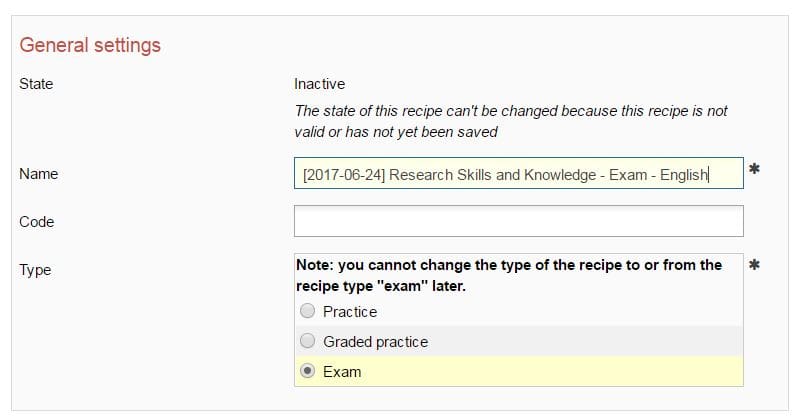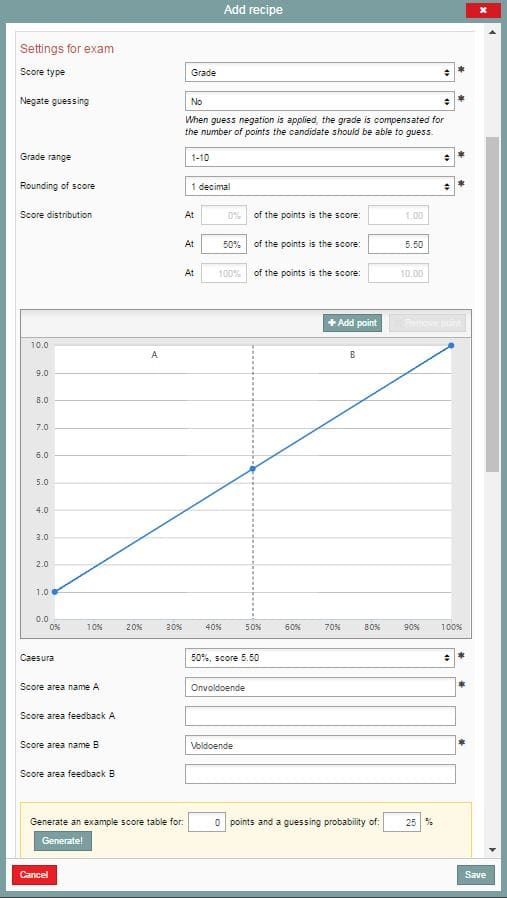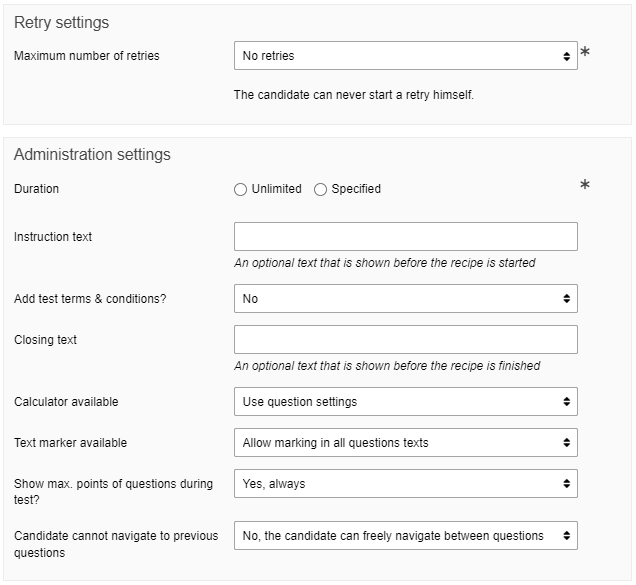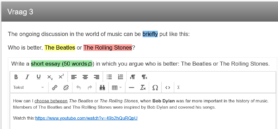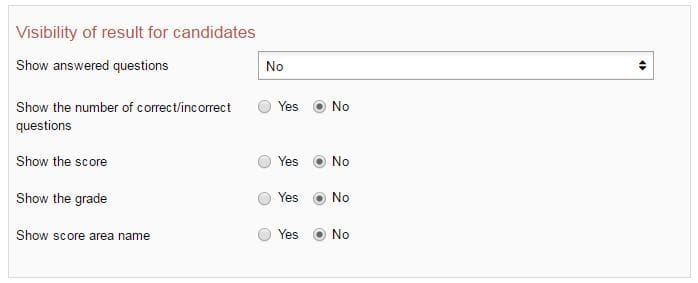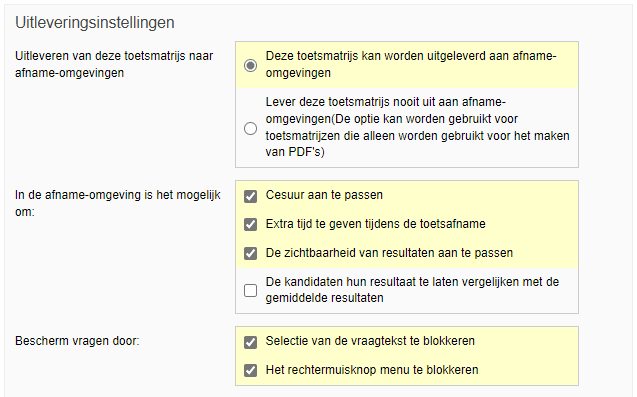Test recipes
Recipe: creating a recipe in ‘Tests’
This page explains how to create a recipe.
-
Step 1
Creating a recipe
- Log in to admin view.
- Go to Tests.
- On the left side of the screen, click ‘Add recipe‘.
-
Step 2
- The settings screen for the exam opens automatically.
-
Step 3
General settings
-
- State: This can be set to active or inactive. When status is set to active, the recipe will be visible in student view.
- Name: Name your exam here. The correct way to name an exam is to start with the date (year, month, date) in square brackets, then the course name, a dash, the type of exam, and finally any additional information: [yyyy-mm-dd] course name – exam type – additional information.
Example: [2017-06-23] Research skills and knowledge – DT 1 – English. - Code: Indicate a code with which your support (key use/functional management) can quickly find your exam. The best format would be: yyyy-mm-dd/coursecode
- Type: Indicate what type of test this is. For summative assessments, select the ‘Exam’ option.
-
-
Please note that once you’ve selected the ‘Type’ of test (Practice, Graded practice, or Exam) and saved the ‘Settings’, the only change you will be able to make to the ‘Type’ is to switch from ‘Practice’ to ‘Graded practice’ and back.
-
Step 4
Settings for exam (top part of the image)
- Score type: Decide how you want to evaluate the exam. The options are grades, points (on a scale of 0 to 20, for instance) or percentage. There are various settings you’ll need to configure for each type.
- Negate guessing: This setting instructs Remindo to automatically correct for the odds of guessing correctly. If you’d like to see the exam’s guessing score, go to the Example tab after saving the recipe settings. The total guessing score across all exam questions will be listed at the top.
- Grade range: Here, you can configure whether grades will range from 0 to 10 or from 1 to 10.
- Round off scores: Fill in your preference.
- Method of rounding off: The options can be found in the drop-down menu in Remindo. By default, the settings at the UU are: normal rules for rounding off, will round down at the cut-off point. Example: when the cut-off point is 5.5, a grade of 5,45 will be rounded down (insufficient).
Other options for rounding off are: regular rounding off rules; Rounding down; Rounding up - Score distribution: This is where you equate percentages of correct answers to a score or grade. The editable field is essentially the same as the caesura: “What percentage of the exam must the student have answered correctly to achieve a 5.5 out of 10?”
-
Step 5
Settings for exam (top part of the image)
- The graph is a visualisation of the score distribution. You can adjust the range by moving the blue dots in the graph around. If you’ve already corrected for chance, don’t correct for it again in the graph!
- Caesura: the pass/fail line when it comes to grading the test.
- Score area name: a score area is the area between two blue points on the graph. You can assign names to each one. The Remindo defaults are ‘Onvoldoende’ (fail) and ‘Voldoende’ (pass).
- Score area feedback: You can link feedback to each score area. The text you enter will be shown to the student when they log in to see their results, provided that setting has been enabled.
- Generate score table: This will show you an overview of the number of points a student must collect to achieve a given grade.
-
Step 6
Retry settings
- Retry settings: How many times can the student resit the exam? During a retry, the student performs the exact same exam you constructed in this recipe.
- If you want to disallow students from taking the exact same exam more than once, set maximum number of retakes to No retries. Students can never start a retry themselves.
- Advice: In practice, it is conventional to set the option ‘maximum number of retries’ to ‘no retries’ in case of an exam (graded). We would also advise you to do so. Retries can best be prepared in the online testing environment as a new ‘Exam’ and only link those who are allowed to retry. Your key user can either do this for you, or you can agree that you will do so yourself. For this ‘exam’, you will have to create a new recipe under a unique name.
-
Step 7
Administration settings (see previous screenshot)
- Duration: Set the maximum duration for your exam. Tell your faculty key user about students who should receive extra time. The key user will ensure that they get it.
- Instruction: the student sees this text before he / she starts the test. The instruction is similar to the text on the cover page of a paper test. The student can always return to the instruction during the test.
- Test conditions: With this option you can use test- or examconditions (in the student-view environment called “Test statement”) prior to a test. Read here how to set the conditions and how the student sees that test statement.
- Closing text: Students will see this when they finish the exam.
- Under Calculator available, select whether to use the question setting in the question (set by default), never to show the calculator (ignores question settings) or to make either the simple or scientific calculator available at will.
- Text marker available (see previous screenshot): You can choose, in the drop-down menu, if you want to allow the candidates to mark text during the exam. By default, the UU uses the following setting: Allow marking in all questions texts. The reason for making this the default setting is because in can help candidates understand the question better if they are allowed to make markings in longer and/or more complex texts. This settings only allows students to make markings in the case study text and/or the entire question. Candidates can also add comments to marked text. Candidates are not able to make markings in their own answers, and markings are not visible in the correction work (see screenshot in the coming yellow field).
- Show max. points of questions during test?: This setting allows the teacher to decide if they want to show the candidates the maximum attainable amount of points for a question. By default, the UU uses the following setting: Yes, always. The reason for this default is because it is important to be transparent towards the candidate regarding the amount of points they can get for every question. This settings also takes away the necessity to always note in the individual questions how many points they are worth.
How does it work: If the setting is on Yes, always, the maximum amount of points for that question will be shown during the test. The option Use settings from the test player has the same effect as Yes, always. When you choose No, never, the maximum amount of points will not be shown during the test.
Note: when you have chosen to show the max. amount of points for a question during the test, the test player will not show the amount of points per sub-question. Moreover, Remindo does also not show partial points in case of multiple response questions.
Evaluation settings:
- Add evaluation field?: It is possible to add an evaluation field. This allows candidates to leave comments regarding the test. These comments will become available through the results overview and a PDF in the planning.
Note! Because evaluations regarding the course are done through Caracal (or another tool), we do NOT recommend using this option. The course evaluation also allows for questions regarding the test(s). - Evaluation URL: it is possible to add a URL in the Evaluation-URL field that will lead the candidate to the course evaluation in Caracal. You can read here how to add an evaluation-URL from Caracal. Students will be able to fill in the course evaluation after finishing the exam.
-
Please note: When the time for the exam elapses, the exam will close down immediately after showing a message. The students’ information will be saved. In Remindo, students who started the exam late will have the same amount of time as students who started on time.
The candidate’s text and colour markings may look like the following:
-
Step 8
Visibility of results for candidates
- Show answered questions: This determines whether students will be able to see the questions after the exam. If they are allowed to see the questions after the exam, you can configure whether they should also be allowed to see the correct answers to the questions.
- Show the number of correct/incorrect questions: Shows the number of correctly/incorrectly answered questions.
- Show the score: shows how many points were awarded.
- Show the grade: shows the grade on the overview.
- Show score area name: this option refers to the ‘Score area name’ fields (Voldoende/Onvoldoende) underneath the graph.
Also see Visibility of results to students.
-
The results can be made available either immediately after the exam or at some later date. Your key user can configure this for you.
-
Step 9
Delivery settings: these settings apply to student view, which is where the exams are performed.
Delivery of this recipe to test players:
- This recipe can be delivered to test players: the exam can be performed in student view.
- Never deliver this recipe to test players: The exam can never be performed digitally because it cannot be delivered to student view.
In the test player (student view) it will be possible to: Always check the following options:
- Edit the caesura: This leaves you with the option of adjusting the caesura after the exam has been performed.
- Give extra time during test taking: This leaves you the option of assigning students extra time during the performance of the exam.
- Edit the visibility of results: This leaves you the option of having the key user change who can see the exam results and when.
- Letting candidates compare their results to the average results: this will keep the option available of letting candidates compare their results to the average results of the candidate group which they are assigned to, and to the average results of other candidate groups for the same exam. Note: only key-users are able to assign students to candidate groups. Discuss the use of this setting therefore with your key-user. When you decide to turn this comparison option on when planning the test moment, students will see a ‘larger-or-equal’ icon on their dashboard for that test. A pop-up will open when they click on this, in which the student can view their own results and the results of their candidate group compared to other (for that test chosen) groups.
Protect questions by:
- Blocking selection of question text: Students will be unable to copy questions or other text in Remindo.
- Blocking the right-click menu: Students will be unable to open the right-click menu during the exam.
-
Step 10
Question details settings: Hide author name?
- When this setting is set to Yes, the author name of the question will be hidden in the question details in the test environment.
- When this setting is set to No, the author name of the question will be visible in the test environment, through Test result > Question details. Students will not be able to see the author name, even when reviewing the test.
-
Step 11
Save recipe
- When you have configured your recipe, click Save at the bottom.
-
-
Step 12
The recipe settings can always be altered at a later date:
- Login to the Admin view.
- Click on Settings to get to the recipe menu.
- The settings will now pop up.
- Execute your alterations.
- Don’t forget to Save the recipe afterwards!



